嵌入式软件工程师综合测试试题
嵌入式系统设计师(基础知识、应用技术)合卷软件资格考试(中级)试题及解答参考(2024年)

2024年软件资格考试嵌入式系统设计师(基础知识、应用技术)合卷(中级)自测试题(答案在后面)一、基础知识(客观选择题,75题,每题1分,共75分)1、下列关于嵌入式系统和一般计算机的区别描述,错误的是( )A. 嵌入式系统一般具有固定的应用场景,而一般计算机则用途更为广泛B. 嵌入式系统一般以实时性、可靠性为主,而一般计算机则更加注重多任务处理能力C. 嵌入式系统应用的功能比较单一,而一般计算机可以运行各种复杂的应用程序D. 嵌入式系统通常用硬件资源有限的微控制器或者微处理器实现,而一般计算机则使用更加强大的处理器和更多内存2、以下哪个选项不是嵌入式系统设计的重要组成部分?( )A. 软件设计B. 硬件设计C. 系统测试D. 网络协议设计3.(单项选择题)以下哪种存储器属于嵌入式系统中的静态随机访问存储器(SRAM)?A. EEPROMB. FLASHC. SDRAMD. ROM4.(多项选择题)关于嵌入式系统的硬件平台,以下哪些描述是正确的?A. 嵌入式系统的硬件平台通常包括处理器、存储器、输入输出设备等。
B. 嵌入式处理器的性能越高,系统的功耗就越大。
C. 嵌入式系统的存储器通常采用SRAM和DRAM两种类型。
D. 嵌入式系统的输入输出设备通常采用串行通信接口进行数据传输。
5.嵌入式系统的定义是什么?A. 一种通用的计算机系统,适用于各种应用场景B. 一种专门为特定应用而设计的计算机系统,通常具有较低的性能和功耗C. 一种用于实时应用的计算机系统,具有高度的可靠性和实时性D. 一种用于网络通信的计算机系统6.嵌入式系统的基本组成部分包括哪些?A. 中央处理器(CPU)、内存、输入/输出(I/O)设备、操作系统B. 中央处理器(CPU)、内存、I/O设备、应用程序C. 中央处理器(CPU)、内存、I/O设备、电源管理单元(PMU)D. 中央处理器(CPU)、内存、I/O设备、网络接口卡(NIC)7、嵌入式系统工程师需要掌握哪些主要的微处理器?(多选)A. ARM Cortex-M3B. RISC-VC. PowerPCD. MIPS8、以下哪个选项不是嵌入式系统的开发工具?(单选)A. EclipseB. Visual StudioC. IAR Embedded WorkbenchD. Git9、ARM处理器的主要特点是什么?A、高性能、低功耗B、高性能、高功耗C、低性能、低功耗D、低性能、高功耗 10、在嵌入式系统中,定时器的作用是什么?A、运算数据B、控制程序执行流程C、精确控制外部设备的工作频率D、所有选项都是定时器的作用11、下列哪种方法不适用于嵌入式系统开发?A. 瀑布模型B. espiral模型C. SCRUMD. XP12、在嵌入式系统中,RTOS(实时操作系统)的主要作用是:A. 提供高性能的核心计算能力B. 管理硬件资源,提供实时任务调度机制C. 开发应用程序界面D. 实现文件系统和网络协议13、在嵌入式系统通常使用的总线和处理器架构中,下列哪一对是全球领先的?()。
嵌入式软件工程师笔试题(含答案)
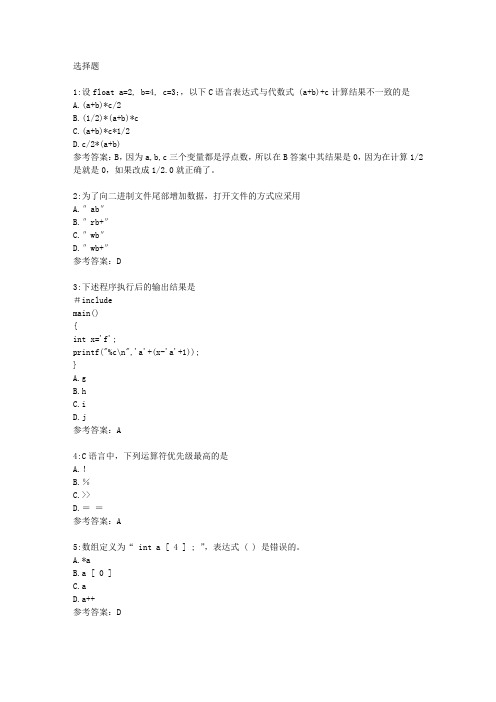
选择题1:设float a=2, b=4, c=3;,以下C语言表达式与代数式 (a+b)+c计算结果不一致的是A.(a+b)*c/2B.(1/2)*(a+b)*cC.(a+b)*c*1/2D.c/2*(a+b)参考答案:B,因为a,b,c三个变量都是浮点数,所以在B答案中其结果是0,因为在计算1/2是就是0,如果改成1/2.0就正确了。
2:为了向二进制文件尾部增加数据,打开文件的方式应采用A.″ab″B.″rb+″C.″wb″D.″wb+″参考答案:D3:下述程序执行后的输出结果是#includemain(){int x='f';printf("%c\n",'a'+(x-'a'+1));}A.gB.hC.iD.j参考答案:A4:C语言中,下列运算符优先级最高的是A.!B.%C.>>D.==参考答案:A5:数组定义为“ int a [ 4 ] ; ”,表达式 ( ) 是错误的。
A.*aB.a [ 0 ]C.aD.a++参考答案:D6:执行语句“ k=7>>1; ”后,变量 k 的当前值是A.15B.31C.3D.1参考答案:C7:定义函数时,缺省函数的类型声明,则函数类型取缺省类型A.voidB.charC.floatD.int参考答案:D8:若main()函数带参数,参数个数最多是A.0B.1C.2D.3参考答案:C 只知道有定义形式main(int argc,char* argv[]))9:若有宏定义:#define MOD(x,y) x%y则执行以下语句后的输出结果是int a=13,b=94;printf(″%d\n″,MOD(b,a+4));A.5B.7C.9D.11参考答案:B10:下列各个错误中,哪一个不属于编译错误A.改变 x 原值 3 为 5 ,写作“ x==5 ;”B.花括号不配对C.复合语句中的最后一条语句后未加分号D.变量有引用、无定义参考答案:A11:下列程序段运行后, x 的值是( )a=1;b=2;x=0;if(!( -- a))x -- ;if(!b)x=7;else ++x;A.0B.3C.6D.7参考答案:A12:设#define N 3#define Y(n) ((N+1)*n)则表达式2*(N+Y(5+1))的值是A.42B.48C.54D.出错参考答案:B Y(5+1) 传递过去的应该是6,而不是简单的把5+1给替换掉13:若定义了char ch[]={″abc\0def″},*p=ch;则执行printf(″%c″,*p+4);语句的输出结果是A.defB.dC.eD.0参考答案:C14:下列转义字符中错误的是A.′\000′B.′\14′C.′\x111′D.′\2′参考答案:C error C2022: '273' : too big for character15:算术运算符,赋值运算符和关系运算符的运算优先级按从高到低依次为A.算术运算、赋值运算、关系运算B.算术运算、关系运算、赋值运算C.关系运算、赋值运算、算术运算D.关系运算、算术运算、赋值运算参考答案:B16:设#define N 3#define Y(n) ((N+1)*n)则表达式2*(N+Y(5+1))的值是A.42B.48C.54D.出错参考答案:B17:表达式 strcmp( “ 3.14 ”,“ 3.278 ” ) 的值是一个A.非零整数B.浮点数C.0D.字符参考答案: A18:设struct{ short a;char b;float c;}cs;则sizeof(cs)的值是A.4B.5C.6D.7参考答案: D 字节对齐的话应该是819:若变量已正确定义,表达式( j=3 , j++ )的值是A.3B.4C.5D.0参考答案:A20:C 语言中运算对象必须是整型的运算符是A.%B./C.!D.**参考答案:A简答题21:打印一个N*N的方阵,N为每边字符的个数( 3〈N〈20 ),要求最外层为“X”,第二层为“Y”,从第三层起每层依次打印数字0,1,2,3,...例子:当N =5,打印出下面的图形:X X X X XX Y Y Y XX Y 0 Y XX Y Y Y XX X X X X22:谈谈COM的线程模型。
嵌入式考试题库及答案

嵌入式考试题库及答案一、单项选择题(每题2分,共20分)1. 在嵌入式系统中,通常采用哪种类型的处理器?A. 通用处理器B. 精简指令集处理器(RISC)C. 复杂指令集处理器(CISC)D. 专用处理器答案:B2. 以下哪个不是嵌入式系统的典型特点?A. 实时性B. 可扩展性C. 资源受限D. 专用性答案:B3. 在嵌入式系统中,以下哪个不是常用的存储介质?A. ROMB. RAMC. 硬盘D. Flash答案:C4. 嵌入式操作系统与通用操作系统的主要区别是什么?A. 嵌入式操作系统更复杂B. 嵌入式操作系统更简单,资源占用少C. 嵌入式操作系统价格更高D. 嵌入式操作系统运行速度更快答案:B5. 以下哪个不是嵌入式系统的应用领域?A. 消费电子B. 工业控制C. 航空航天D. 办公自动化答案:D6. 在嵌入式系统中,通常使用哪种类型的编程语言?A. 汇编语言B. 高级语言C. 机器语言D. 以上都是答案:D7. 以下哪个不是嵌入式系统的开发工具?A. 编译器B. 调试器C. 项目管理软件D. 文字处理软件答案:D8. 在嵌入式系统中,以下哪个不是常用的通信协议?A. TCP/IPB. USARTC. I2CD. USB答案:D9. 嵌入式系统的功耗通常与什么因素有关?A. 处理器速度B. 存储容量C. 系统复杂度D. 以上都是答案:D10. 以下哪个不是嵌入式系统的开发流程?A. 需求分析B. 系统设计C. 编码实现D. 产品发布答案:D二、多项选择题(每题3分,共15分)1. 嵌入式系统的开发过程中,以下哪些是必须考虑的因素?A. 系统性能B. 成本控制C. 系统安全性D. 用户体验答案:ABCD2. 在嵌入式系统中,以下哪些是常见的输入设备?A. 触摸屏B. 键盘C. 鼠标D. 传感器答案:ABD3. 以下哪些是嵌入式系统开发中常用的软件工具?A. 集成开发环境(IDE)B. 版本控制系统C. 项目管理工具D. 数据库管理系统答案:ABC4. 在嵌入式系统中,以下哪些是常见的输出设备?A. 显示器B. 扬声器C. 打印机D. LED灯答案:ABD5. 嵌入式系统的测试通常包括哪些方面?A. 功能测试B. 性能测试C. 安全性测试D. 稳定性测试答案:ABCD三、填空题(每题2分,共20分)1. 嵌入式系统通常由、、和四个部分组成。
软件资格考试嵌入式系统设计师(基础知识、应用技术)合卷(中级)试卷及答案指导(2025年)

2025年软件资格考试嵌入式系统设计师(基础知识、应用技术)合卷(中级)模拟试卷(答案在后面)一、基础知识(客观选择题,75题,每题1分,共75分)1、嵌入式系统通常指的是什么?A、运行在个人计算机上的操作系统B、运行在专用硬件平台上的软件系统C、用于数据处理的通用软件D、用于网络通信的软件系统2、以下哪个概念不属于嵌入式系统设计的关键要素?A、实时性B、资源优化C、可靠性D、用户界面友好性3、题干:在嵌入式系统中,通常使用哪种类型的微处理器?A. 通用微处理器B. 嵌入式微处理器C. 数字信号处理器D. 光子微处理器4、题干:在嵌入式系统设计中,以下哪种通信接口通常用于高速数据传输?A. SPI(串行外设接口)B. I2C(两线式串行接口)C. CAN(控制器局域网)D. USB(通用串行总线)5、以下关于嵌入式系统设计的基本概念,错误的是:A. 嵌入式系统通常由硬件和软件两部分组成B. 嵌入式系统通常具有实时性要求C. 嵌入式系统设计过程中,硬件和软件的设计往往是相互独立的D. 嵌入式系统通常具有有限的资源6、在嵌入式系统设计中,以下哪个技术用于提高系统的可靠性和稳定性?A. 双机热备份B. 软件冗余C. 实时操作系统D. 硬件冗余7、嵌入式系统中的中断服务程序(ISR)通常采用以下哪种优先级管理方式?A. 固定优先级B. 动态优先级C. 分级优先级D. 无优先级8、在嵌入式系统中,以下哪种存储器在系统运行时不能被重新编程?A. ROM(只读存储器)B. RAM(随机存储器)C. EEPROM(电可擦可编程只读存储器)D. Flash Memory(闪存)9、嵌入式系统中的“中断服务程序”(Interrupt Service Routine,ISR)主要作用是什么?10、以下哪项不是嵌入式系统设计中常见的硬件抽象层(HAL)的功能?11、题目:嵌入式系统通常由哪些主要组成部分构成?A. 微处理器、存储器、输入输出接口、电源B. 微控制器、操作系统、通信接口、应用软件C. 处理器、总线、内存、I/O设备D. 中央处理器、外部设备、操作系统、编程语言12、题目:以下哪个是嵌入式系统的典型应用?A. 智能家居系统B. 计算机操作系统C. 高速互联网交换机D. 大型数据库管理系统13、嵌入式系统中的中断服务程序(ISR)通常具有哪些特点?A. 优先级固定,不可改变B. 执行时间短,响应速度快C. 可由用户自定义执行流程D. 必须在主程序中显式调用14、在嵌入式系统中,以下哪种存储器类型适合用于存储程序代码?A. RAMB. ROMC. EEPROMD. Flash Memory15、嵌入式系统中的实时操作系统(RTOS)与传统操作系统的主要区别是什么?16、在嵌入式系统中,为什么通常使用C语言进行编程?17、嵌入式系统中的中断处理通常采用哪种方式来确保中断服务程序(ISR)能够及时响应?A. 优先级中断B. 中断嵌套C. 中断向量表D. 硬件优先级18、在嵌入式系统设计中,下面哪个不是影响系统实时性的因素?A. CPU的性能B. 外设的响应速度C. 操作系统的调度策略D. 电源的稳定性19、题目:嵌入式系统设计中,实时操作系统(RTOS)与传统操作系统的区别主要在于:A. 实时性要求B. 用户界面C. 处理器架构D. 存储管理 20、题目:在嵌入式系统设计中,以下哪项技术不属于嵌入式系统硬件设计领域?A. 硬件电路设计B. 微处理器选型C. 软件编程D. 电源设计21、题目:在嵌入式系统中,以下哪个组件是负责处理CPU和外设之间的数据传输?A. 总线控制器B. 存储器控制器C. 通信接口D. 输入输出设备22、题目:以下哪种技术常用于嵌入式系统的实时性能优化?A. 多任务处理B. 代码优化C. 事件驱动D. 硬件加速23、嵌入式系统中,以下哪个部件负责存储和管理程序代码和数据处理?A. 微处理器(CPU)B. 外部存储器(如硬盘、U盘)C. 存储器(RAM、ROM)D. 输入输出设备(如键盘、显示器)24、以下哪种通信接口在嵌入式系统中广泛应用于串行通信?A. USBB. I2CC. SPID. CAN25、题目:以下哪个是嵌入式系统的基本组成部分?A. 处理器、存储器、输入输出设备B. 电源、控制器、执行器C. 硬件、软件、接口D. 系统软件、应用软件、网络26、题目:以下哪个不是嵌入式系统的特点?A. 实时性B. 可靠性C. 便携性D. 开放性27、嵌入式系统设计过程中,功耗管理是一个重要环节,以下哪种方法不是降低功耗的有效措施?A. 提高处理器的主频以加快任务处理速度B. 使用动态电压调节技术C. 在不使用时关闭不需要的外设D. 使用低功耗的硬件组件28、在嵌入式系统开发中,RTOS是指什么?A. 实时操作系统B. 可编程逻辑控制器C. 图形用户界面D. 高级程序设计语言29、嵌入式系统中的“裸机”指的是什么?30、以下哪个不是嵌入式系统的特点?A. 实时性B. 专用性C. 网络通信能力D. 系统资源丰富31、在嵌入式系统中,以下哪种存储器是非易失性的,并且可以进行电擦除和重写?A. SRAMB. DRAMC. EEPROMD. Flash32、关于中断处理,下列哪一项描述是不正确的?A. 中断向量表存放了中断服务程序的入口地址。
嵌入式软件试题(难度低)
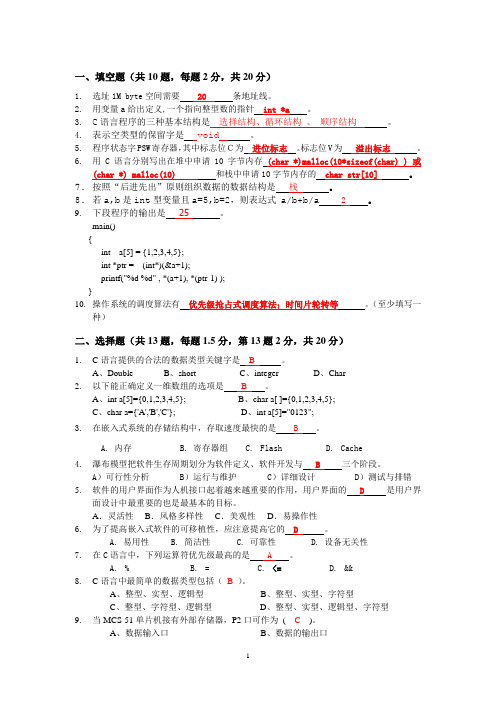
一、填空题(共10题,每题2分,共20分)1.选址1M byte空间需要20条地址线。
2.用变量a给出定义,一个指向整型数的指针int *a。
3.C语言程序的三种基本结构是选择结构、循环结构、顺序结构。
4.表示空类型的保留字是void。
5.程序状态字PSW寄存器,其中标志位C为进位标志。
标志位V为溢出标志。
6.用C语言分别写出在堆中申请10字节内存(char *)malloc(10*sizeof(char) ) 或(char *) malloc(10) 和栈中申请10字节内存的char str[10] 。
7.按照“后进先出”原则组织数据的数据结构是栈。
8.若a,b是int型变量且a=5,b=2,则表达式a/b+b/a 2 。
9.下段程序的输出是25。
main(){int a[5] = {1,2,3,4,5};int *ptr = (int*)(&a+1);printf("%d %d" , *(a+1), *(ptr-1) );}10.操作系统的调度算法有优先级抢占式调度算法;时间片轮转等。
(至少填写一种)二、选择题(共13题,每题1.5分,第13题2分,共20分)1.C语言提供的合法的数据类型关键字是B。
A、DoubleB、shortC、integerD、Char2.以下能正确定义一维数组的选项是B。
A、int a[5]={0,1,2,3,4,5};B、char a[ ]={0,1,2,3,4,5};C、char a={'A','B','C'};D、int a[5]="0123";3.在嵌入式系统的存储结构中,存取速度最快的是 B 。
A. 内存B. 寄存器组C. FlashD. Cache4.瀑布模型把软件生存周期划分为软件定义、软件开发与 B三个阶段。
A)可行性分析B)运行与维护C)详细设计D)测试与排错5.软件的用户界面作为人机接口起着越来越重要的作用,用户界面的D是用户界面设计中最重要的也是最基本的目标。
嵌入式系统软件开发工程师认证试卷
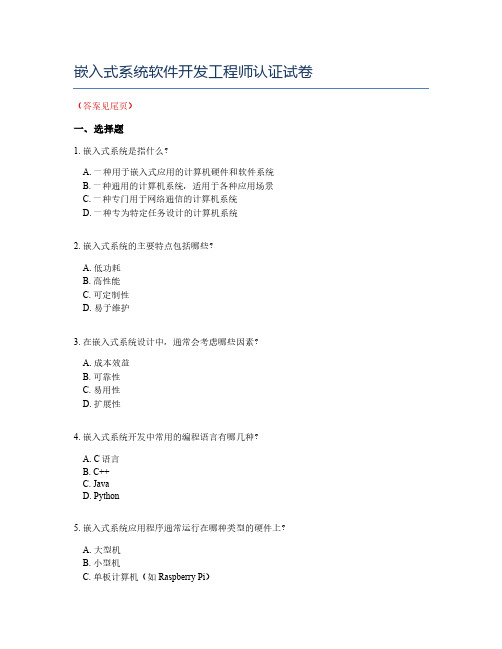
嵌入式系统软件开发工程师认证试卷(答案见尾页)一、选择题1. 嵌入式系统是指什么?A. 一种用于嵌入式应用的计算机硬件和软件系统B. 一种通用的计算机系统,适用于各种应用场景C. 一种专门用于网络通信的计算机系统D. 一种专为特定任务设计的计算机系统2. 嵌入式系统的主要特点包括哪些?A. 低功耗B. 高性能C. 可定制性D. 易于维护3. 在嵌入式系统设计中,通常会考虑哪些因素?A. 成本效益B. 可靠性C. 易用性D. 扩展性4. 嵌入式系统开发中常用的编程语言有哪几种?A. C语言B. C++C. JavaD. Python5. 嵌入式系统应用程序通常运行在哪种类型的硬件上?A. 大型机B. 小型机C. 单板计算机(如Raspberry Pi)6. 在嵌入式系统开发过程中,调试是一个重要的环节。
以下哪些是常用的调试方法?A. 内存分析工具B. 调试器C. 观察法D. 日志分析7. 嵌入式系统通常用于哪些领域?A. 消费电子产品B. 工业控制系统C. 医疗设备D. 汽车电子8. 在嵌入式系统设计中,如何确保系统的安全性和可靠性?A. 使用高质量的组件B. 采用冗余设计C. 定期进行系统更新和维护D. 所有选项都正确9. 嵌入式系统软件开发工程师需要具备哪些技能?A. 熟练掌握编程语言B. 具备嵌入式系统的硬件知识C. 能够进行系统设计和架构规划D. 了解操作系统原理10. 在嵌入式系统软件开发过程中,如何处理软件和硬件的交互?A. 使用操作系统提供的APIB. 编写特定的驱动程序C. 使用库函数和中间件D. 以上都是11. 嵌入式系统的主要特点是什么?B. 低功耗C. 可扩展性D. 扩展性12. 嵌入式系统的核心是什么?A. 中央处理器(CPU)B. 内存管理单元(MMU)C. 输入输出设备D. 操作系统和软件13. 在嵌入式系统开发中,硬件平台的选择非常重要。
以下哪个因素不是选择硬件平台时需要考虑的因素?A. 成本B. 可靠性C. 开发周期D. 性能E. 功耗14. 下面哪个编程语言通常用于嵌入式系统开发?A. PythonB. C++C. JavaD. 汇编语言15. 嵌入式系统中的实时性是指什么?A. 系统响应时间短B. 系统不间断运行C. 系统能够处理大量数据D. 系统具有高优先级16. 在嵌入式系统开发过程中,调试是一个关键步骤。
嵌入式工程师笔试试卷及答案
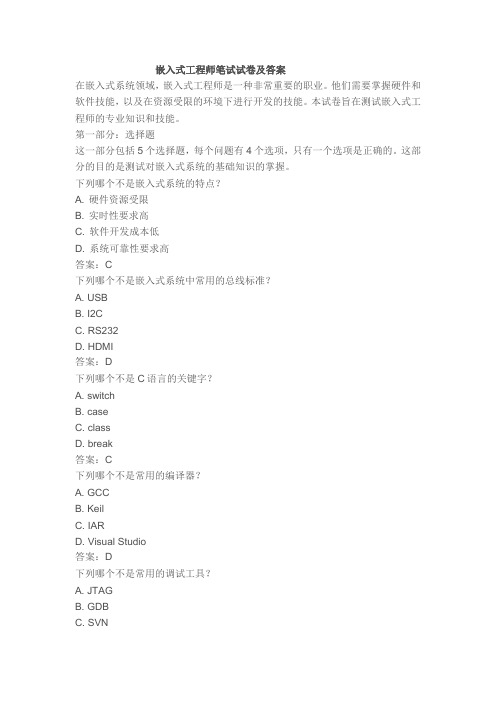
嵌入式工程师笔试试卷及答案在嵌入式系统领域,嵌入式工程师是一种非常重要的职业。
他们需要掌握硬件和软件技能,以及在资源受限的环境下进行开发的技能。
本试卷旨在测试嵌入式工程师的专业知识和技能。
第一部分:选择题这一部分包括5个选择题,每个问题有4个选项,只有一个选项是正确的。
这部分的目的是测试对嵌入式系统的基础知识的掌握。
下列哪个不是嵌入式系统的特点?A. 硬件资源受限B. 实时性要求高C. 软件开发成本低D. 系统可靠性要求高答案:C下列哪个不是嵌入式系统中常用的总线标准?A. USBB. I2CC. RS232D. HDMI答案:D下列哪个不是C语言的关键字?A. switchB. caseC. classD. break答案:C下列哪个不是常用的编译器?A. GCCB. KeilC. IARD. Visual Studio答案:D下列哪个不是常用的调试工具?A. JTAGB. GDBC. SVND. Trace32答案:C第二部分:简答题这一部分包括2个简答题,每个问题需要回答2-3个句子。
这部分的目的是测试对嵌入式系统的基本原理和通信协议的理解。
什么是中断?中断的作用是什么?答:中断是指在CPU运行程序的过程中,由于某些事件的发生,需要立即暂停当前程序的执行,转而去执行另一段代码的一种机制。
中断的作用是提高CPU 的利用率,增强系统的实时性和可靠性,实现CPU与外设的异步通信。
请简述I2C总线的工作原理。
答:I2C总线是一种串行通信协议,通过两根线SCL和SDA实现设备间的通信。
SCL线是时钟线,由主设备控制;SDA线是数据线,用于主设备和从设备之间的数据传输。
在传输数据时,主设备先发送起始信号,然后发送从设备地址和读/写标志,接着发送数据或者请求数据,最后发送停止信号。
从设备在接收到起始信号后,会根据地址来判断是否需要响应主设备的请求。
第三部分:编程题这一部分包括2个编程题,需要在规定的环境下编写代码。
嵌入式软件工程师综合测试试题答案

综合复习试题第一部分:C语言一、请填写BOOL , float, 指针变量与“零值”比较的 if 语句。
提示:这里“零值”可以是0, 0.0 , FALSE或者“空指针”。
例如 int 变量 n 与“零值”比较的 if 语句为:if ( n == 0 )if ( n != 0 )二、以下为Windows NT下的32位C++程序,请计算sizeof的值三、简答题1、头文件中的 ifndef/define/endif 干什么用?答:防止该头文件被重复引用。
2、#include <filename.h> 和 #include “filename.h”有什么区别?答:对于#include <filename.h> ,编译器从标准库路径开始搜索 filename.h 对于#include “filename.h”,编译器从用户的工作路径开始搜索filename.h3、const 有什么用途?(请至少说明两种)答:(1)可以定义 const 常量(2)const 可以修饰函数的参数、返回值,甚至函数的定义体。
被 const 修饰的东西都受到强制保护,可以预防意外的变动,能提高程序的健壮性。
4、在C++ 程序中调用被 C编译器编译后的函数,为什么要加 extern “C”声明?答:C++语言支持函数重载,C 语言不支持函数重载。
函数被 C++编译后在库中的名字与 C 语言的不同。
假设某个函数的原型为: void foo(int x, int y);该函数被 C 编译器编译后在库中的名字为_foo,而 C++编译器则会产生像_foo_int_int 之类的名字。
C++提供了 C 连接交换指定符号 extern“C”来解决名字匹配问题。
5、请简述以下两个for循环的优缺点四、有关内存的思考题五、编写strcpy函数已知strcpy函数的原型是char *strcpy(char *strDest, const char *strSrc);其中strDest是目的字符串,strSrc是源字符串。
嵌入式软件开发岗位招聘笔试题及解答(某大型国企)2025年

2025年招聘嵌入式软件开发岗位笔试题及解答(某大型国企)(答案在后面)一、单项选择题(本大题有10小题,每小题2分,共20分)1、在嵌入式软件开发中,以下哪个不是常见的硬件接口?A. SPI接口B. USB接口C. UART接口D. I2C接口2、嵌入式系统中,下列哪种编程语言最适合用于开发实时操作系统?A. JavaB. PythonC. C++D. JavaScript3、嵌入式系统中,以下关于ARM架构描述错误的是:A. ARM架构低功耗、高性能B. ARM架构主要用于移动计算和嵌入式领域C. ARM架构不支持多媒体和DSP功能D. ARM架构具有灵活的技术授权模式4、在嵌入式软件开发中,关于实时操作系统的描述错误的是:A. 实时操作系统具有高度的响应性和确定性B. 实时操作系统主要应用于实时性要求不高的场景C. 实时操作系统可以确保任务的及时完成和响应需求D. 实时操作系统常用于工业控制、医疗设备等领域5、在嵌入式软件开发中,以下哪种编程语言因其高性能和对低级硬件的控制能力而被广泛使用?A. PythonB. JavaC. CD. JavaScript6、嵌入式系统的核心特点是:A. 计算机视觉B. 无线通信C. 实时响应D. 数据存储7、在嵌入式软件开发中,以下哪个选项是实时操作系统的特点?A. 具有固定的时间表B. 可以根据需要动态调整任务优先级C. 仅适用于单处理器系统D. 不支持多任务处理8、在嵌入式系统中,通常使用哪种类型的存储器?A. 硬盘驱动器C. 光盘D. 闪存9、嵌入式软件开发中,关于内存管理的说法错误的是:A. 动态内存分配是指在程序运行时动态地分配或释放内存。
B. 静态内存分配在程序开始运行时进行,并在程序结束时释放。
C. 内存泄漏是指分配给程序的内存没有得到及时回收,导致内存占用持续增长。
D. 为了避免内存溢出,应该尽可能多地分配内存空间。
10、关于嵌入式系统的说法,错误的是:A. 嵌入式系统通常运行在特定硬件平台上,并对硬件环境有较强依赖性。
嵌入式考试题目及答案
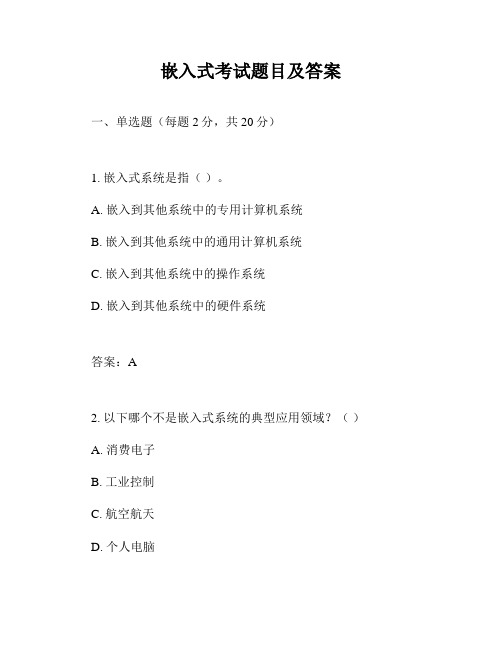
嵌入式考试题目及答案一、单选题(每题2分,共20分)1. 嵌入式系统是指()。
A. 嵌入到其他系统中的专用计算机系统B. 嵌入到其他系统中的通用计算机系统C. 嵌入到其他系统中的操作系统D. 嵌入到其他系统中的硬件系统答案:A2. 以下哪个不是嵌入式系统的典型应用领域?()A. 消费电子B. 工业控制C. 航空航天D. 个人电脑答案:D3. 在嵌入式系统中,以下哪个不是常用的处理器类型?()A. 微控制器(MCU)B. 数字信号处理器(DSP)C. 微处理器(MPU)D. 网络处理器(NP)答案:D4. 以下哪个不是嵌入式系统的开发工具?()A. 编译器B. 调试器C. 仿真器D. 打印机答案:D5. 在嵌入式系统中,以下哪个不是操作系统的功能?()A. 任务调度B. 内存管理C. 文件系统D. 网络通信答案:D6. 以下哪个不是嵌入式系统的硬件组成?()A. 处理器B. 存储器C. 输入/输出设备D. 显示器答案:D7. 在嵌入式系统中,以下哪个不是软件组成?()A. 操作系统B. 应用程序C. 驱动程序D. 打印机驱动答案:D8. 以下哪个不是嵌入式系统的开发流程?()A. 需求分析B. 系统设计C. 编码D. 测试答案:D9. 在嵌入式系统中,以下哪个不是调试技术?()A. 断点B. 单步执行C. 代码覆盖率分析D. 性能优化答案:D10. 以下哪个不是嵌入式系统的可靠性要求?()A. 容错性B. 可预测性C. 可维护性D. 可扩展性答案:D二、多选题(每题3分,共15分)11. 嵌入式系统的特点是()。
A. 实时性B. 专用性C. 可扩展性D. 低功耗答案:ABD12. 嵌入式系统的开发工具包括()。
A. 编译器B. 调试器C. 仿真器D. 打印机答案:ABC13. 嵌入式系统的硬件组成包括()。
A. 处理器B. 存储器C. 输入/输出设备D. 显示器答案:ABC14. 嵌入式系统的软件组成包括()。
嵌入式考试题目和答案
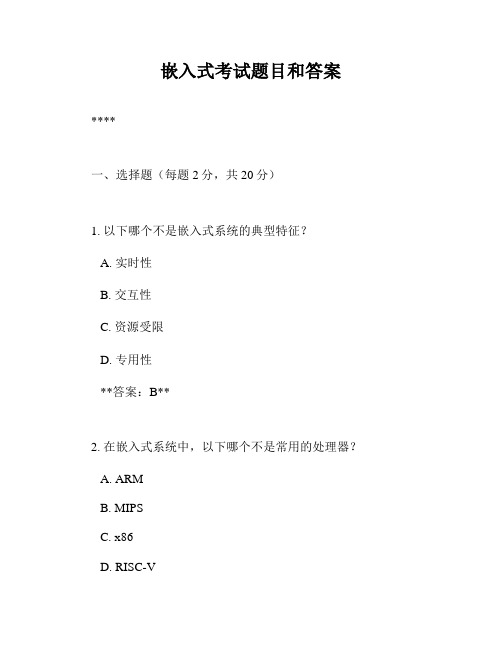
嵌入式考试题目和答案****一、选择题(每题2分,共20分)1. 以下哪个不是嵌入式系统的典型特征?A. 实时性B. 交互性C. 资源受限D. 专用性**答案:B**2. 在嵌入式系统中,以下哪个不是常用的处理器?A. ARMB. MIPSC. x86D. RISC-V**答案:C**3. 嵌入式操作系统中,哪个不是任务调度的基本策略?A. 先来先服务(FCFS)B. 轮询调度(Round Robin)C. 优先级调度D. 随机调度**答案:D**4. 在嵌入式系统中,以下哪个不是常用的存储介质?A. EEPROMB. FlashC. RAMD. CD-ROM**答案:D**5. 以下哪个不是嵌入式系统开发中常用的编程语言?A. CB. C++C. JavaD. Python**答案:D**6. 以下哪个不是嵌入式系统中常用的通信接口?A. UARTB. I2CC. USBD. VGA**答案:D**7. 在嵌入式系统中,以下哪个不是常用的电源管理技术?A. 睡眠模式B. 动态电压调节C. 软件重启D. 电源门控**答案:C**8. 以下哪个不是嵌入式系统的调试工具?A. JTAGB. SWDC. RS-232D. GDB**答案:C**9. 在嵌入式系统中,以下哪个不是常用的操作系统?A. LinuxB. VxWorksC. AndroidD. Windows**答案:D**10. 以下哪个不是嵌入式系统设计中的考虑因素?A. 功耗B. 成本C. 性能D. 外观**答案:D**二、填空题(每题2分,共20分)1. 嵌入式系统通常由______、______、______三部分组成。
**答案:硬件、软件、固件**2. 在嵌入式系统中,______是指系统在规定时间内完成其功能的能力。
**答案:实时性**3. 嵌入式系统的______是指系统在有限的资源下运行的能力。
**答案:资源受限**4. 嵌入式系统的______是指系统在特定应用领域内的高度专业化。
嵌入式软件笔试题(含答案)
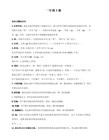
X X X X X
X Y Y Y X
X Y 0 Y X
X Y Y Y X
X X X X X
22:谈谈COM的线程模型。然后讨论进程内/外组件的差别。
23:多态类中的虚函数表是Compile-Time,还是Run-Time时建立的?
参考答案:
虚拟函数表是在编译期就建立了,各个虚拟函数这时被组织成了一个虚拟函数的入口地址的数组.
A.15
B.31
C.3
D.1
参考答案:C
7:定义函数时,缺省函数的类型声明,则函数类型取缺省类型
A.void
B.char
C.float
DHale Waihona Puke int 参考答案:D 8:若main()函数带参数,参数个数最多是
A.0
B.1
C.2
D.3
参考答案:C 只知道有定义形式main(int argc,char* argv[]))
#define N 3
#define Y(n) ((N+1)*n)
则表达式2*(N+Y(5+1))的值是
A.42
B.48
C.54
D.出错
参考答案:B Y(5+1) 传递过去的应该是6,而不是简单的把5+1给替换掉
13:若定义了char ch[]={″abc\0def″},*p=ch;则执行printf(″%c″,*p+4);语句的输出结果是
(3)将栈B的栈顶元素pop出;这样实现的队列入队和出队的平摊复杂度都还是O(1),
26:写一语句实现x是否为2的若干次幂的判断。
软件资格考试嵌入式系统设计师(基础知识、应用技术)合卷(中级)试题与参考答案(2024年)

2024年软件资格考试嵌入式系统设计师(基础知识、应用技术)合卷(中级)模拟试题(答案在后面)一、基础知识(客观选择题,75题,每题1分,共75分)1、嵌入式系统通常由哪些主要部件组成?()A、微处理器、存储器、输入/输出设备、通信接口B、中央处理器、随机存储器、只读存储器、输入/输出设备C、微控制器、外部存储器、接口电路、电源D、处理器、总线、接口、电源2、下列哪个术语描述了嵌入式系统设计中的一个关键特性?()A、可扩展性B、可靠性C、可维护性D、用户友好性3、题干:嵌入式系统中,通常采用C语言进行编程的原因有哪些?4、题干:以下哪种设备不属于嵌入式系统的范畴?5、嵌入式系统中,下列哪项技术不属于实时性技术?()A. 实时多任务操作系统(RTOS)B. 实时时钟(RTC)C. 实时监控(RTS)D. 实时文件系统(RTFS)6、在嵌入式系统设计中,以下哪个组件负责处理系统与外部环境的交互?()A. CPUB. 存储器C. I/O设备D. 总线7、嵌入式系统中,通常采用哪种方式对存储器进行寻址?A. 直接寻址B. 静态重定位寻址C. 动态重定位寻址D. 随机寻址8、以下哪种技术用于在嵌入式系统中实现实时操作系统(RTOS)?A. 实时内核技术B. 实时扩展技术C. 实时仿真技术D. 实时监控技术9、嵌入式系统中的中断服务程序(ISR)通常具有哪些特点?A、执行时间短B、优先级固定C、不能返回调用者D、以上都是 10、在嵌入式系统中,以下哪种存储器通常用于存放程序代码?A、RAMB、ROMC、EEPROMD、NOR Flash11、在嵌入式系统中,以下哪种存储器类型适合用于存储需要快速访问且不易丢失数据的场合?A. ROM(只读存储器)B. RAM(随机存取存储器)C. EEPROM(电可擦可编程只读存储器)D. Flash Memory(闪存)12、在嵌入式系统设计中,以下哪种通信接口主要用于短距离、高速数据传输?A. USB(通用串行总线)B. CAN(控制器局域网)C. Ethernet(以太网)D. RS-23213、在嵌入式系统开发中,以下哪个选项不是RTOS(实时操作系统)的主要特性?A. 高效的任务调度机制B. 超高的计算能力C. 可靠性与稳定性D. 实时响应能力14、关于嵌入式系统的电源管理,下列哪一项描述是错误的?A. 动态电压调整可以降低功耗B. 睡眠模式是一种有效的节能措施C. 电源管理仅在系统设计初期考虑D. 智能电源管理策略能够延长电池寿命15、嵌入式系统设计中,通常所说的“实时性”指的是什么?16、以下哪项不是嵌入式系统硬件平台设计的主要考虑因素?17、在嵌入式系统设计过程中,以下哪一项不是硬件抽象层(HAL)的主要功能?A. 提供统一的硬件访问接口B. 实现硬件设备驱动程序C. 隔离操作系统与硬件平台差异D. 直接管理硬件资源分配18、在嵌入式系统开发中使用RTOS(实时操作系统)的主要优点是什么?A. 增加系统的复杂性B. 提高系统成本C. 支持多任务并行处理并保证任务响应时间D. 减少系统开发周期19、嵌入式系统中的中断处理通常包括哪些步骤?20、在嵌入式系统中,为什么需要使用看门狗定时器(Watchdog Timer,WDT)?21、下列关于嵌入式系统的描述哪个是正确的?A. 嵌入式系统设计中无需考虑功耗问题。
嵌入式工程师考试题

选择题
在嵌入式系统开发中,以下哪种编程语言通常不用于底层驱动开发?
A. C
B. C++
C. Python(正确答案)
D. 汇编语言
嵌入式系统中,中断服务程序(ISR)的主要特点是?
A. 执行时间长
B. 可被其他中断打断
C. 响应速度快(正确答案)
D. 占用大量内存
下列哪项不是嵌入式处理器选择时需要考虑的因素?
A. 处理速度
B. 功耗
C. 外形尺寸(正确答案)
D. 成本
在嵌入式系统设计中,RTOS(实时操作系统)的主要作用是?
A. 提供图形用户界面
B. 管理硬件资源和任务调度(正确答案)
C. 实现网络通信功能
D. 处理数据输入输出
嵌入式系统中,DMA(直接内存访问)技术主要用于?
A. 加快CPU运算速度
B. 实现内存与外设之间的高速数据传输(正确答案)
C. 增加内存容量
D. 提高系统安全性
下列哪种接口通常不用于嵌入式系统中的数据传输?
A. UART
B. SPI
C. HDMI(正确答案,通常用于高清视频输出)
D. I2C
在嵌入式软件开发中,以下哪种调试方法不是常用的?
A. 使用JTAG进行硬件调试
B. 通过串口输出调试信息
C. 利用仿真器进行软件模拟
D. 直接在最终产品上进行测试(正确答案)
下列哪项不是嵌入式系统设计中需要考虑的实时性指标?
A. 响应时间
B. 吞吐量
C. 系统复杂度(正确答案)
D. 任务执行周期。
嵌入式工程师测试题及答案

嵌入式工程师测试题及答案一、单项选择题(每题2分,共20分)1. 在嵌入式系统中,以下哪个不是实时操作系统的特点?A. 多任务B. 多用户C. 确定性D. 可预测性答案:B2. 下列哪种编程语言通常不用于嵌入式系统开发?A. C语言B. PythonC. C++D. Java答案:B3. 以下哪个设备不是嵌入式系统?A. 智能手机B. 微波炉C. 个人电脑D. 智能手表答案:C4. 在嵌入式系统中,中断服务程序的主要作用是什么?A. 处理用户输入B. 管理文件系统C. 响应外部事件D. 执行操作系统任务答案:C5. 以下哪个协议不是用于嵌入式设备网络通信的?A. TCP/IPB. HTTPC. BluetoothD. USB答案:B6. 在嵌入式系统中,以下哪种存储器不是易失性的?A. SRAMB. DRAMC. EEPROMD. Flash答案:C7. 在嵌入式系统中,以下哪个概念与硬件无关?A. 时钟周期B. I/O端口C. 寄存器D. 函数答案:D8. 在嵌入式系统中,以下哪个是操作系统的组成部分?A. 编译器B. 汇编器C. 内核D. 链接器答案:C9. 嵌入式系统中的设备驱动程序的主要功能是什么?A. 管理内存分配B. 管理文件系统C. 提供硬件与操作系统之间的接口D. 执行系统调用答案:C10. 在嵌入式系统中,以下哪个不是操作系统的任务?A. 进程管理B. 内存管理C. 硬件管理D. 编译源代码答案:D二、多项选择题(每题3分,共15分)1. 在嵌入式系统开发中,以下哪些是常用的调试工具?A. 逻辑分析仪B. 调试器C. 编译器D. 仿真器答案:ABD2. 以下哪些是嵌入式系统中常用的通信接口?A. UARTB. SPIC. USBD. HDMI答案:ABC3. 在嵌入式系统中,以下哪些是常用的外设?A. LCD显示屏B. 触摸屏C. 键盘D. 打印机答案:ABC4. 在嵌入式系统中,以下哪些是常用的编程模式?A. 事件驱动B. 轮询C. 多线程D. 阻塞答案:ABC5. 在嵌入式系统中,以下哪些是操作系统提供的服务?A. 任务调度B. 内存分配C. 文件系统管理D. 网络服务答案:ABCD三、判断题(每题2分,共10分)1. 嵌入式系统通常具有较低的计算能力。
软件资格考试嵌入式系统设计师(基础知识、应用技术)合卷(中级)试题及解答参考(2025年)

2025年软件资格考试嵌入式系统设计师(基础知识、应用技术)合卷(中级)模拟试题(答案在后面)一、基础知识(客观选择题,75题,每题1分,共75分)1.下列哪个选项不属于嵌入式系统的特点?A. 特殊用途B. 资源受限C. 需实时性D. 可独立运行E. 功能单一2.以下哪种结构属于嵌入式系统常见的分层结构模型之一?A.君主专制结构B.分级管理结构C.层叠结构D.联邦结构E.单元结构3、以下关于嵌入式系统设计要求的说法正确的是()。
A.嵌入式系统要有特色功能,所以不需要有专用处理核心 B.嵌入式系统的性能不一定是最高的,但它们的可靠性一定是最高的 C.嵌入式系统设计不会针对特定的应用要求定制化产品 D.嵌入式系统设计的实时性和专用性,能够使系统满足应用中的各种需要4、ARM处理器有严格的时钟频率和工作频率,若clock频率为16MHz,则工作频率不能低于()。
A.4MHz B.8MHz C.16MHz D.32MHz5.(单选题)在嵌入式系统中,以下关于微处理器的叙述中,哪一项是不正确的?A. 微处理器是嵌入式系统的核心部件。
B. 微处理器的时钟频率直接决定了其运算速度。
C. 所有微处理器的指令集架构都是完全相同的。
D. 微处理器的功耗取决于其复杂性和工作方式。
6.(多选题)关于嵌入式系统的内存管理,以下哪些说法是正确的?A. 嵌入式系统的内存管理通常采用静态分配方式。
B. 动态内存分配在嵌入式系统中很少使用,因为容易造成资源泄露和碎片化问题。
C. 嵌入式系统的内存优化主要涉及合理分配内存空间和降低功耗两个方面。
D. 在嵌入式系统中,垃圾回收机制与操作系统的内存管理机制紧密相关。
7.嵌入式系统的基本概念嵌入式系统是一种专用的计算机系统,通常被嵌入到其他设备中,以实现特定的功能。
它通常包括微处理器、内存、输入/输出接口等组件。
请简述嵌入式系统的特点。
8.嵌入式操作系统的分类嵌入式操作系统可以分为多种类型,主要包括实时操作系统(RTOS)、多任务操作系统和单任务操作系统。
嵌入式系统设计师(基础知识、应用技术)合卷软件资格考试(中级)试卷及答案指导(2025年)
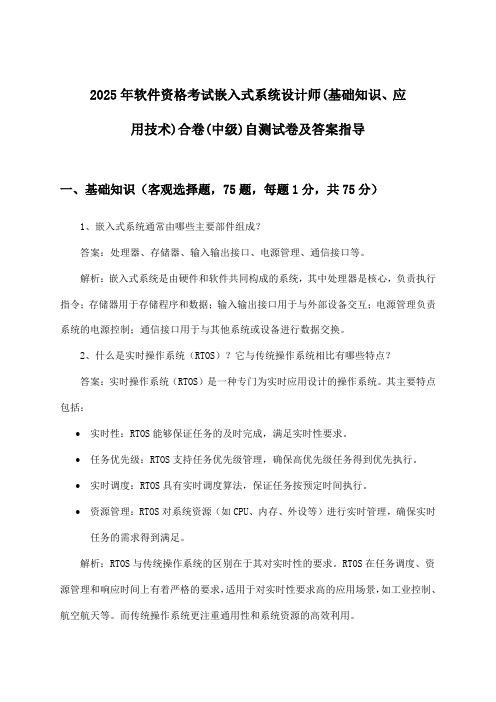
2025年软件资格考试嵌入式系统设计师(基础知识、应用技术)合卷(中级)自测试卷及答案指导一、基础知识(客观选择题,75题,每题1分,共75分)1、嵌入式系统通常由哪些主要部件组成?答案:处理器、存储器、输入输出接口、电源管理、通信接口等。
解析:嵌入式系统是由硬件和软件共同构成的系统,其中处理器是核心,负责执行指令;存储器用于存储程序和数据;输入输出接口用于与外部设备交互;电源管理负责系统的电源控制;通信接口用于与其他系统或设备进行数据交换。
2、什么是实时操作系统(RTOS)?它与传统操作系统相比有哪些特点?答案:实时操作系统(RTOS)是一种专门为实时应用设计的操作系统。
其主要特点包括:•实时性:RTOS能够保证任务的及时完成,满足实时性要求。
•任务优先级:RTOS支持任务优先级管理,确保高优先级任务得到优先执行。
•实时调度:RTOS具有实时调度算法,保证任务按预定时间执行。
•资源管理:RTOS对系统资源(如CPU、内存、外设等)进行实时管理,确保实时任务的需求得到满足。
解析:RTOS与传统操作系统的区别在于其对实时性的要求。
RTOS在任务调度、资源管理和响应时间上有着严格的要求,适用于对实时性要求高的应用场景,如工业控制、航空航天等。
而传统操作系统更注重通用性和系统资源的高效利用。
3、在嵌入式系统中,以下哪项不是常见的处理器架构类型?A. ARMB. MIPSC. x86D. DSP答案:C解析:ARM(Advanced RISC Machine)、MIPS(Microprocessor without Interlocked Pipeline Stages)和DSP(Digital Signal Processor)都是常见的嵌入式处理器架构。
而x86是个人计算机中广泛使用的处理器架构,主要用于通用计算机系统,不是嵌入式系统的常见架构。
因此,选项C是正确答案。
4、以下哪个选项描述了嵌入式系统与通用计算机系统的最显著区别?A. 嵌入式系统通常具有更高的运算速度B. 嵌入式系统通常具有更低的功耗C. 嵌入式系统通常具有更大的存储容量D. 嵌入式系统通常具有更复杂的用户界面答案:B解析:嵌入式系统与通用计算机系统最显著的区别之一是功耗。
嵌入式考试题目及答案

嵌入式考试题目及答案一、单项选择题(每题2分,共20分)1. 嵌入式系统的特点是()。
A. 体积小、功耗低、可靠性高B. 体积大、功耗高、可靠性低C. 体积小、功耗高、可靠性低D. 体积大、功耗低、可靠性高答案:A2. 以下哪个不是嵌入式操作系统的特点?()A. 实时性B. 多任务C. 可扩展性D. 复杂性答案:D3. 嵌入式系统的硬件核心是()。
A. 微处理器B. 微控制器C. 存储器D. 输入输出设备答案:B4. 在嵌入式系统中,以下哪个不是常用的总线标准?()A. I2CB. SPIC. USBD. Ethernet答案:D5. 嵌入式系统的软件开发不包括以下哪个阶段?()A. 需求分析B. 系统设计C. 编码D. 硬件设计答案:D6. 以下哪个不是嵌入式系统的开发工具?()A. 编译器B. 调试器C. 仿真器D. 路由器答案:D7. 嵌入式系统中,以下哪个不是常用的编程语言?()A. C语言B. C++C. JavaD. Python答案:D8. 在嵌入式系统中,以下哪个不是常用的存储介质?()A. EEPROMB. FlashC. RAMD. 硬盘答案:D9. 嵌入式系统的功耗优化不包括以下哪个方面?()A. 硬件优化B. 软件优化C. 系统优化D. 外观优化答案:D10. 以下哪个不是嵌入式系统的可靠性测试?()A. 抗干扰测试B. 温度测试C. 湿度测试D. 色彩测试答案:D二、多项选择题(每题3分,共15分)1. 嵌入式系统的开发流程包括()。
A. 需求分析B. 系统设计C. 编码D. 测试E. 维护答案:ABCDE2. 嵌入式系统的硬件设计需要考虑的因素包括()。
A. 性能B. 成本C. 功耗D. 体积E. 可靠性答案:ABCDE3. 嵌入式系统的软件设计需要考虑的因素包括()。
A. 实时性B. 可移植性C. 可维护性D. 可扩展性E. 稳定性答案:ABCDE4. 嵌入式系统的测试包括()。
2025年软件资格考试嵌入式系统设计师(中级)(基础知识、应用技术)合卷试卷及答案指导

2025年软件资格考试嵌入式系统设计师(基础知识、应用技术)合卷(中级)复习试卷(答案在后面)一、基础知识(客观选择题,75题,每题1分,共75分)1.题目:在嵌入式系统中,下列哪种硬件设备通常用于实现设备与CPU之间的通信?A. 存储器B. 输入输出接口C. 中断控制器D. 时钟发生器2.题目:在嵌入式系统的开发过程中,以下哪个阶段不属于需求分析阶段的工作?A. 制定项目计划B. 编写需求规格说明书C. 设计系统架构D. 编写测试用例3.在嵌入式系统中,下列哪项不是系统的基本组成部分?A. 硬件设备B. 软件程序C. 用户界面D. 网络连接4.在嵌入式系统中,以下哪个不是常见的编程语言?A. C语言B. JavaC. PythonD. JavaScript5.(单选题)关于嵌入式系统的内存管理,以下说法错误的是:A. 嵌入式系统的内存管理通常采用静态分配方式。
B. 动态内存分配可以提高系统的灵活性和响应速度。
C. 嵌入式系统的内存泄露问题是影响系统稳定性的一个重要因素。
D. 使用嵌入式系统的硬件抽象层可以有效地避免内存泄漏。
7.在嵌入式系统中,以下哪个不是常见的处理器类型?A. ARM Cortex-M系列B. RISC-VC. MIPSD. x868.嵌入式系统中,存储器通常分为哪几类?A. 只读存储器ROMB. 随机存取存储器RAMC. 只写存储器ROMD. 可擦除可编程只读存储器EPROM9.嵌入式系统的基本定义•题目:嵌入式系统是指将______ 与______ 结合在一起的系统,它通常用于控制、监视或辅助操作设备、机器或用于工厂运作的设备。
10.嵌入式系统的特点•题目:嵌入式系统的主要特点包括______、______、______ 和______ 。
11.在嵌入式系统中,以下哪个不是常见的处理器架构?A. ARMB. MIPSC. x86D. PowerPC12.嵌入式系统开发中,通常使用哪种编程语言进行应用程序开发?A. JavaB. C/C++C. PythonD. Ruby13.嵌入式系统设计中,以下哪种硬件设备通常用于存储程序和数据?A. 微处理器B. 存储器C. 输入输出接口D. 通信接口14.在嵌入式系统中,以下哪个概念不属于硬件范畴?A. 微处理器B. 存储器C. 通信接口D. 输入输出接口15.嵌入式系统的基本概念嵌入式系统是一种专用的计算机系统,通常被嵌入到其他设备或系统中。
嵌入式软件工程师笔试题
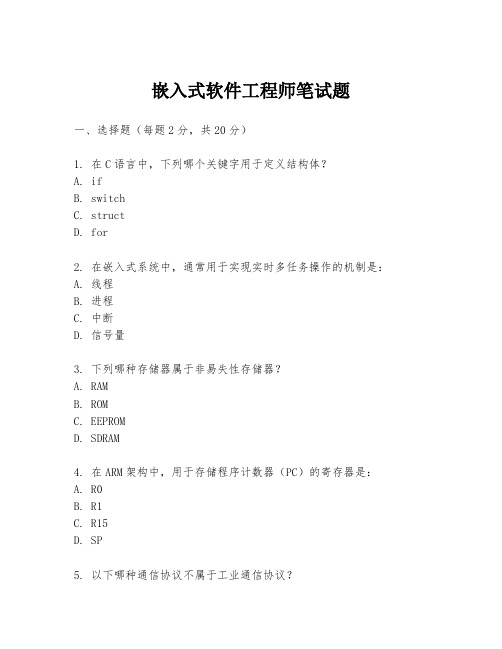
嵌入式软件工程师笔试题一、选择题(每题2分,共20分)1. 在C语言中,下列哪个关键字用于定义结构体?A. ifB. switchC. structD. for2. 在嵌入式系统中,通常用于实现实时多任务操作的机制是:A. 线程B. 进程C. 中断D. 信号量3. 下列哪种存储器属于非易失性存储器?A. RAMB. ROMC. EEPROMD. SDRAM4. 在ARM架构中,用于存储程序计数器(PC)的寄存器是:A. R0B. R1C. R15D. SP5. 以下哪种通信协议不属于工业通信协议?A. ModbusB. CANC. HTTPD. Profibus6. 在嵌入式Linux开发中,设备树(Device Tree)的主要作用是:A. 描述硬件信息B. 配置内核参数C. 管理文件系统D. 运行应用程序7. 以下哪个是实时操作系统(RTOS)的特点?A. 支持多任务B. 支持多线程C. 支持图形界面D. 支持网络通信8. 在C语言中,用于动态分配内存的函数是:A. mallocB. freeC. callocD. realloc9. 以下哪种传感器通常用于测量物体的速度?A. 加速度传感器B. 陀螺仪C. 霍尔传感器D. 光电传感器10. 在嵌入式系统中,串行通信接口UART的主要作用是:A. 连接显示器B. 连接键盘C. 连接鼠标D. 连接串行设备二、填空题(每题2分,共20分)11. 在C语言中,使用关键字________可以定义一个指向函数的指针。
12. 在嵌入式系统中,________是一种常用的低功耗无线通信技术。
13. 为了在嵌入式设备中实现网络功能,通常需要使用________协议栈。
14. 在嵌入式Linux系统中,使用________命令可以查看当前系统的进程信息。
15. 一个典型的嵌入式系统通常包括硬件平台、________、外设和应用程序。
16. 在ARM架构中,异常处理程序通常存储在向量表的________部分。
- 1、下载文档前请自行甄别文档内容的完整性,平台不提供额外的编辑、内容补充、找答案等附加服务。
- 2、"仅部分预览"的文档,不可在线预览部分如存在完整性等问题,可反馈申请退款(可完整预览的文档不适用该条件!)。
- 3、如文档侵犯您的权益,请联系客服反馈,我们会尽快为您处理(人工客服工作时间:9:00-18:30)。
综合测试试题第一部分:C语言一、请填写BOOL , float, 指针变量与“零值”比较的if 语句。
提示:这里“零值”可以是0, 0.0 , FALSE或者“空指针”。
例如int 变量n 与“零值”比较的if 语句为:if ( n == 0 )if ( n != 0 )以此类推。
请写出BOOL flag 与“零值”比较的if 语句:请写出float x 与“零值”比较的if 语句:请写出char *p 与“零值”比较的if 语句:二、以下为Windows NT下的32位C++程序,请计算sizeof的值char str[] = “Hello” ; char *p = str ;int n = 10;请计算sizeof (str ) =sizeof ( p ) =sizeof ( n ) = void Func ( char str[100]) {请计算sizeof( str ) =}void *p = malloc( 100 ); 请计算sizeof ( p ) =三、简答题1、头文件中的ifndef/define/endif 干什么用?2、#include <filename.h> 和#include “filename.h” 有什么区别?3、const 有什么用途?(请至少说明两种)4、在C++ 程序中调用被C编译器编译后的函数,为什么要加extern “C”声明?5、请简述以下两个for循环的优缺点// 第一个for (i=0; i<N; i++) {if (condition)DoSomething();elseDoOtherthing(); } // 第二个if (condition){for (i=0; i<N; i++) DoSomething();}else{for (i=0; i<N; i++) DoOtherthing(); }优点:缺点:优点:缺点:四、有关内存的思考题void GetMemory(char *p){p = (char *)malloc(100);}void Test(void){char *str = NULL;GetMemory(str);strcpy(str, "hello world"); printf(str);}请问运行Test函数会有什么样的结果?答:char *GetMemory(void){char p[] = "hello world";return p;}void Test(void){char *str = NULL;str = GetMemory();printf(str);}请问运行Test函数会有什么样的结果?答:Void GetMemory2(char **p, int num) {*p = (char *)malloc(num);}void Test(void){char *str = NULL;GetMemory(&str, 100);strcpy(str, "hello");printf(str);}请问运行Test函数会有什么样的结果?答:void Test(void){char *str = (char *) malloc(100);strcpy(str, “hello”);free(str);if(str != NULL){strcpy(str, “world”);printf(str);}}请问运行Test函数会有什么样的结果?答:五、编写strcpy函数已知strcpy函数的原型是char *strcpy(char *strDest, const char *strSrc);其中strDest是目的字符串,strSrc是源字符串。
(1)不调用C++/C的字符串库函数,请编写函数strcpychar *strcpy(char *strDest, const char *strSrc){assert((strDest != NULL) && (strSrc != NULL));char *address = strDest;while ( (*strDest++ = *strSrc++) != '\0' );return address;}(2)strcpy能把strSrc的内容复制到strDest,为什么还要char * 类型的返回值?为了实现链式表达式int length = strlen( strcpy (strDest, "hello world!"));六:编程题1、写出程序把一个链表中的接点顺序倒排listNode* reverse_list( listNode* head) //逆序{ListNode* new_head=head;if(head==NULL || head->next==NULL)return head;new_head = reverse_list(head->next);head->next->next=head;head->next=NULL; //防止链表成为一个环,这是最关键的。
return new_head;}2、写出程序删除链表中的所有接点void del_all(node *head){node *p;while(head!=NULL){p=head->next;free(head);head=p;}cout<<"释放空间成功!"<<endl;}3、使用冒泡、选择法、快速排序法对数组进行排序第二部分:C++与QT1.C++对C语言做了很多改进,下列描述中(D)使得C语言发生了质变,即从面向过程变成面向对象。
A)增加了一些新的运算符B)允许函数重载,并允许设置默认参数C)规定函数说明必须用原型D)引进类和对象的概念2.下面说法中正确的是(B )A)一个类只能定义一个构造函数,但可以定义多哥析构函数(只能一个)B)一个类只能定义一个析构函数,但可以定义多个构造函数C)构造函数与析构函数同名,只是名字前加了一个求反符号(~)D)构造函数(不)可以指定返回类型,而析构函数不能指定任何返回类型,即使是void类型也不可以3.下面关于友元的描述中,错误的是(D)。
A) 友元函数可以访问该类的私有数据成员。
B) 一个类的友元类中的成员函数都是这个类的友元函数。
C) 友元可以提高程序的运行效率。
D) 类与类之间的友元关系可以继承。
4.有关析构函数的说法不正确的是(B)。
A) 析构函数有切仅有一个B) 析构函数和构造函数一样(不)可以有形参C) 析构函数的功能是用来释放一个对象D) 析构函数无任何函数类型5.下列对重载函数的描述中,(A)是错误的。
A) 重载函数中不允许使用默认参数B) 重载函数中编译时根据参数表进行选择C) 不要使用重载函数来描述毫无相干的函数D) 构造函数重载将会给初始化带来多种方式6.下面叙述错误的是( C )A.派生类可以使用private派生B.对基类成员的访问必须是无二义性的C.基类成员的访问能力在派生类中维持不变D.赋值兼容规则也适用于多继承的组合一、选择题:(共10小题,每题3分)1.类的构造函数被自动调用执行的情况是在定义该类的( C )A)成员函数时B)数据成员时C)对象时D)友元函数时2.说明友元函数使用关键字( A )A)friendB)staticC)constD)colatile3.已知类X中的一个成员函数说明如下:Void Set(x &a); 其中,X&a的含义是(C )A)指向类X的指针为aB)将a的地址赋给变量SstC)a是类X的对象引用,用来做为Set()的形参D)变量X是a按位相与作为函数Set()的参数4.关于new运算符的下列描述中( D )是错误的.//创建数组时,定义构造函数必须没有参数,或全部为默认参数A) 它可以用来动态创建对象和对象数组B) 使用它创建对象或对象数组,可以使用运算符DELETE删除C) 使用它创建对象时要调用构造函数D) 使用它调用对象数组时不许指定初始值5.允许访问类的所有对象的私有成员,公有成员和保护成员的是( A )A)友元函数B)成员函数C)内联函数D)重载函数6.局部变量可以隐藏全局变量,那么在有同名全局变量和局部变量的情形时,可以用(A )提供对全局变量的访问A)域运算符B)类运算符C)重载D)引用7.缺省析构函数的函数体是(C )A)不存在B)随机产生的C)空的D)无法确定的、8.通常拷贝构造函数的参数表是(C)//在VC6.0下A)该类对象名//编译不会通过B)该类对象的成员名//编译可以通过,但不是通常的标准方法C)该类对象的引用名//标准拷贝构造函数的方法D)该类对象的指针名//编译可以通过,但不是通常的标准方法9.对定义重载函数的下列要求中,(D )是错误的A)要求参数的个数不同B)要求参数中至少有一个类型不同C)要求参数个数相同时,参数类型不同D)要求函数的返回值不同10.对于多重继承,有(D )A.一个派生类只能有一个基类B.一个基类只能产生一个派生类C.一个基类必须产生多个派生类D.一个派生类可有多个基类7.C和C++有什么不同?(4分)8.面向对象的三个基本特征及各自的作用(6分)9.c和c++中的struct有什么不同?(5分)10.const符号的作用有哪些?(5分)11.引用与指针有什么区别?(6分)12.重载(overload)和重写(overried,有的书也叫做“覆盖”)的区别?(4分)13.static 在类内修饰成员的作用是什么,如何引用这些成员?(4分)14.虚析构函数的作用是什么?(6分)15.类成员函数的重载、覆盖和隐藏区别?16.在C中引用C++语言中的函数和变量时,C++的头文件需添加extern "C",但是在C语言中不能直接引用声明了extern "C"的该头文件,应该仅将C文件中将C++中定义的extern "C"函数声明为extern类型。
三、编程题:(共3小题每小题10分)17.编写一个字符串处理的类,MyString,实现拷贝构造,‘=’号重载等基本函数。
18.使用MyString作为成员对象实现一个Person类,包含:姓名,年龄。
19.实现一个Student 类:有性名,年龄,学号,老师姓名。
20.编写类String的构造函数、析构函数和赋值函数已知类String的原型为:class String{public:String(const char *str = NULL); // 普通构造函数String(const String &other); // 拷贝构造函数~ String(void); // 析构函数String & operate =(const String &other); // 赋值函数 private:char *m_data; // 用于保存字符串};请编写String的上述4个函数。
